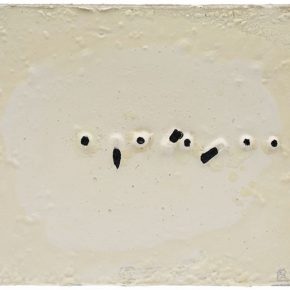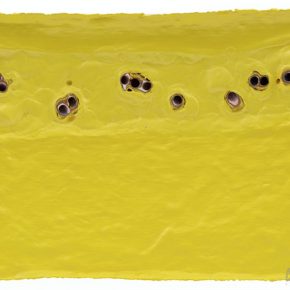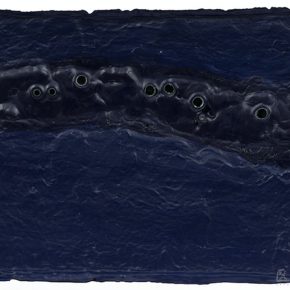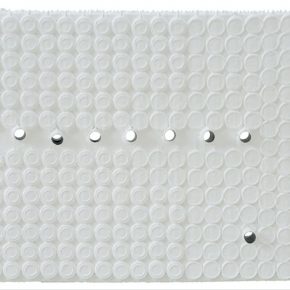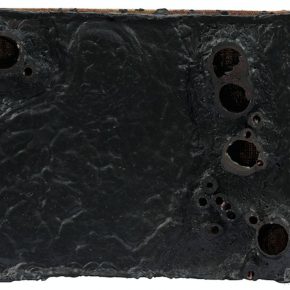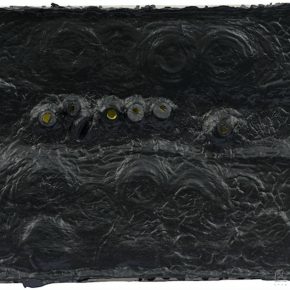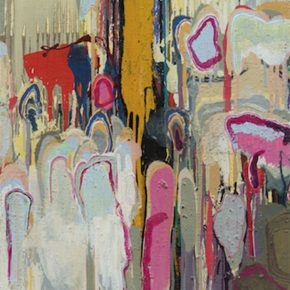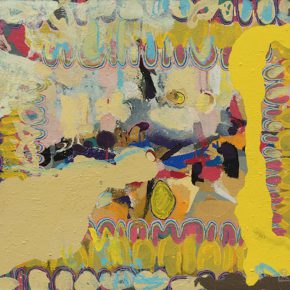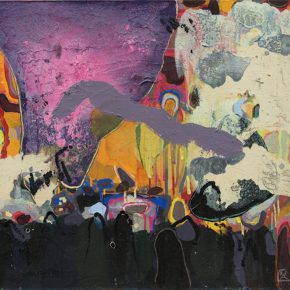
“Trace and Trace of ‘Space’” is the first solo exhibition of the artist Liu Wenjiong in the Cheng Project, this exhibition presents his creative exploration of “space” since 2016. Liu Wenjiong’s creation benefited from his “interdisciplinary” manner of working over the past 15 years, while the thinking and practice of the “space” of the screen has been able to build a grammatical logic of his own painting under the continuing efforts and research of the scholar.
Liu Wenjiong is like a creator of contemporary art, but at the same time, he is recognized as a scholar of art, culture and social history. He was engaged in the study of folk art during his postgraduate study in 2004, and started to study the intangible cultural heritage. In 2009, he studied the archeology of art during his doctoral study, and he was admitted to the Beijing University in 2016 to study the regional social history art during the postdoctoral study.
Along with the extensive, in-depth and long-term study on cultural relics in theclassroom and field, Liu Wenjiong increasingly focuses on the spiritualprecipitation and special beauty behind it, and returns to the screen of creation.The pursuit of time in the discipline brings the artist to poetry and meditation on acreative concept level. In the “interdisciplinary” action and process: it both affectsthe expressive objects on the level of spirit and concept, and restricts the expression of the level of technology and language. Especially the subtlety andresponsibility between both, and the resulting dislocation and confusion, whichmakes Liu Wenjiong fascinated.
It is entitled “Trace and Trace of ‘Space’”, while the concept of “space” has been studied by Liu Wenjiong for more than 10 years, the specific relationship between space and spiritual dimension, and the relationship between space and history and location of the object is the uninterrupted thinking and practice of the artist. In 2016, the artist started to perfectly unify his artistic practice and academic research. When the artist enhanced his archaeological knowledge and methods during the study of the discipline, he tried to perform the spiritual traces of cultural relics on the screen, and also slowly began to create the“destruction” of the screen, which is like the mottled wall and tracing inarchaeology. Namely constantly implanting new factors, and two different spatial orientations that appear on the screen – “double spaces”, the effect of color layers similar to slices, is created by the layer superimposed by the second one which are both shrinking, so that the artist obtains a certain degree of freedom.
When he had a technical association with the details of the “Double Spaces”, it inspires the artist to change and create the “Negative Space” series in order to draw using color layers, and also makes the work three-dimensional.
Liu Wenjiong accidentally remembered an excavated case told by the professor in the course of “Archeology of Art” in 2004: he found two small holes in the ground, because the shape was rarely seen, and seemingly required the use of a special method so he immersed gypsum in the empty holes of the rotten woodenware, it resulted in the emergence of the whole shape of Konghou (an ancient plucked stringed instrument).
Liu Wenjiong naturally uses the archaeological “technological operation” – from the perspective of stratigraphy to reverse the process of archaeological excavation, to explore a new “special material”, to naturally solve the problem that he has been thinking of, fighting against the existing logic of painting, and then finishing the “negative space” of the screen. This material is the thing-in-itself of “spatial” formation in the “Negative Space” series, and naturally wraps the surfaces after it is processed. It is obvious that these works do not only mobilize the visual experience of the audience, but also lead the audience and the artist to enter together the historical logic of time. As the artist said, “archaeological excavations are carried out in real spatial dimensions, while there is a link to translation in the painting.”
The “trace” is not only the trace of the static state, “trace of space”, but also a dynamic trajectory, depicting the process of the artist entering spatial reconstruction from the reproduction of space, and establishing Liu Wenjiong’s “archaeological inverse method” with the process of the implementation method of “space”, to form an unique language of painting and the formation of logic. This started from “double spaces” to “negative space”, it implies the huge differences and changes of “space” with the emergence of holes or caves in the canvas. So far, “space” becomes “trace”. The exhibition remains on view till September 23.
About the exhibition
Title: Trace and Trace of “Space”
Opening: 16:00, August 31, 2017
Duration: August 31 - September 23, 2017
Hours: 10:00 am to 10:00 pm
Venue: Cheng Project (NL3011-3012, West Building, North District, Beijing International Trade Mall, Chaoyang District, Beijing)
Courtesy of the artist, translated by Chen Peihua and edited by Sue/CAFA ART INFO.


